#streamflow
Explore tagged Tumblr posts
Text




#nature#water#stream#naturephotography#outdoors#river#scenery#flowingwater#waterflow#waterphotography#runningwater#creek#highflow#streamflow#rushingwater#watercurrent#peacefulstream#naturelovers#colorado
12 notes
·
View notes
Text
𝓗𝓾𝓷𝓽𝓮𝓻
a/n: this is sorta a filler chapter, nothings special really happens. Y’all get some insight to Hunter!readers character.
Word Count : 745
Trigger Warnings: child abuse, depression, war, war crimes, imprisonment, torture, abuse, predatory behavior, anxiety, nightmares, suicidal thoughts, death gore, murder, teen pregnancy, drug abuse, alcohol addiction, just heavy themes all around
Chapter Two
Home Sweet Home

Y/n quickly left the car and grabbed her bags. She dashed to the door whipping around Kai it was locked.
“Keys!” She yelled at her father who was grabbing Bella’s bags. With a smile through the ring of keys which she caught quickly. She jammed them in, shooting the door open with such enthusiasm it made her dad assisted chuckle softly dissipate their awkwardness.
Right there on the door frame were small indictments of the girls height over the ages. There names scribbled atop the door, Y/n felt a tears streamflow her face. She remembered the last summer she was home. Bella was with her and Y/n wanted to ensure she left some mark of Bella to see.
The then twelve Bella was two inches shorter than the ten year old Y/n. She looked around her home giggly and watching Asher memories flashed before her eyes. She ran up all the stairs, logging her bags with ease.
She pulled open the attic door hatch, throwing her bags and crawling up. Her e/c eyes weld with tears as she stared at her childhood room. It was left in a perfect condition.
Her books were laid in the shelves, her stuffed animals and dolls in the corner, her bed against the far end of the room next to the window. It was all perfect. She ran and jumped into her bed. Her body bounced softly as she laughed happily. The cozy mix of rose pinks and lilac covered the room.
“I kept it all the same, except the desk. Thought you might like it.” Charlie’s voice rang through. Y/n shot up staring at her dad with the brightness smile. She nodded her head eagerly.
“It’s perfect daddy! You kept it all the same!” She cheered as she kicked her legs. As she laid in her bed Charlie walked over to her, opening one of her many bags. He pulled out a stuffed brown bear, Lockheed.
Charlie stared down at the bear, he remembered the day he brought Y/n home. She clutched the bear tightly, her only remaining object of her past. Charlie carefully set the bear next to Y/n with a smile.
“You still got this old bugger?” Y/n grabbed Lockheed with a smile. She rested him on her stomach.
“Of course, he stays always.” Charlie ruffled Y/n’s hair and began to tread down the open hatch.
“It good to have you home, my little soldier.” Y/n smiled. Her dad had no idea how literal that name was to her now. As Charlie disappeared under the hatch Y/n couldn’t help but feel that gut piercing feeling of guilt. As she began to unpack all her stuff she grew annoyed at the thought of doing it all.
“๒ץ Շђє ק๏ฬєг ๏Ŧ ђєг๓єร, ﻮเשє ๓є รקєє๔!” Y/n mumbled. Her body began to speed around the room at an inhuman pace. The floor did not creak under her nor did the soft pink and white rug move as she danced over it. Soon her bags were unpacked and all her things were placed away.
All that was left was her duffle bag. She dumped the contents onto her bed. Daggers, axes, crossbow with many enchant bolts, bow, quiver, enchanted arrows, two spears, sickles, sai, guns and ammunition were just to name a few.
Her eyes popped out of her skull as she stared at all the weapons that poured from her bag. Kellan made sure that she would be well prepared. She quickly placed them all back into her bag and slid the bag under her bed. She find a better place to put them later.
She wandered downstairs to Bella’s room with a smile. She leaned against the door frame with a smirk.
“Need some help Bells?” Y/n pondered an amused look on her face. Bella was struggling to place her suitcase upon a high shelve in her closet. Sheepishly Bella looked away as Y/n helped her. A noise outside the window grasped both girls attention.
They went to the window and saw their father with two people. One a boy around Y/n’s age and one an older man in a wheelchair.
Y/n stared at the boy with a knowing smile. His shinning brown skin against the grey sky, glossy long raven hair, and his eyes are dark and deep in color. They were rich like the very dirt they would play together in when they were little.
Jacob Black Y/n thought with a smirk. My how you’ve grown.

Taglist
@svtbpbts
Divider creadit @saradika-graphics
Previous /Next
#twilight x reader#bella swan x reader#jacob black x reader#jacob black x you#edward cullen x reader#jasper hale x reader#rosalie hale x reader#emmett cullen x reader#alice cullen x reader#esme cullen x reader#carlisle cullen x reader#𝓗𝓾𝓷𝓽𝓮𝓻
145 notes
·
View notes
Text

Toothless and Soundbreak’s first brood: Streamflow (F), Plummet (M), and Vanish (F). Although it’s not shown in the picture, both Streamflow and Vanish inherited the sails on their backs, however Streamflow has spikes on the sides of her tail and Vanish has the tail frills like her brother, Plummet.
#how to train your dragon#httyd#httyd 3#httyd thw#httyd 3 au#httyd thw rewrite#night fury#light fury#light fury redesign#my art
13 notes
·
View notes
Text
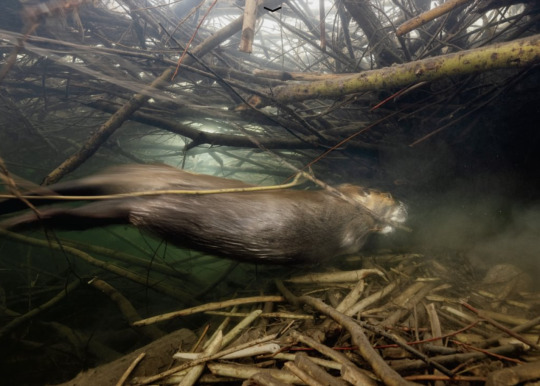
What we can learn from the genius of beavers
National Geographic, June 2025
Words by Ben Goldfarb, photo by Ronan Donovan
(can't link the article, but if you have Libby, you probably have online access through your library.)
Once hunted to near extinction for their pelts and later villainized as a nuisance, beavers have rebounded. There are now 10 to 15 million swimming and waddling across most of North America, and they’re ready for their third act, cast in an improbable role: ecological saviors to a climate change–ravaged world. And fire mitigation is just the start. By building dams that slow streamflow, they create reservoirs that help combat drought; by sculpting wetlands, they furnish habitat for other animals.
Nowhere is their return more necessary than in the climate-stressed American West, where beaver restoration is unfolding, to some extent, in every state. But beavers, tireless meddlers with a penchant for running afoul of human infrastructure, aren’t yet universally welcome.
[...]
In 2008 Gresham had excavated an elaborate maze of berms and canals, known as the Columbia Slough Regional Water Quality Facility, to capture the heavy metals, nitrates, and pesticides that habitually ran off streets and into the nearby Columbia and Willamette Rivers. To the city’s dismay, beavers dammed the ditches, sabotaging humans’ best-laid plans. Workers destroyed the dams and trapped the beavers, but the beavers came back.
The animals, Holzer finally figured, were there to stay—so why not study them? When she analyzed the water trickling past their dams, she discovered something extraordinary: Beaver ponds were cleaning Gresham’s stormwater better than the water-quality facility had without them. Mercury, copper, lead, and zinc settled out in ponds and were trapped within the sediment, and woody lattices of dams further strained out contaminants. Bird diversity increased, and salamanders hid in the dams’ cool crevices. Beavers, Holzer said, “are a perfect self-maintaining system. After every storm, they come out and patch things up for free.”
[...]
On a recent spring day, I visited Birch Creek, a stream in southern Idaho [...]. I walked upstream with Jay Wilde, a rancher who sported a battered cowboy hat and a drooping mustache. Every 60 feet or so, Birch Creek was stapled by another dam—some 80 feet long, some 10 feet high, some that formed staircases of mirrored, acre-wide lakes. Lobes of water shot onto the floodplain, single channels split into twisted strands, and beaver-dug canals spiderwebbed everywhere. A few neglected grass-covered dams melted into the landscape. It was glorious chaos, a mess of water and wood that scarcely resembled a discrete stream.
This was a recent transformation. Wilde had grown up along Birch Creek, which supported his family’s homestead. By the late 1990s, though, the stream had dwindled to a pitiful trickle that would dry up by the Fourth of July. Birch Creek had lost its beavers, Wilde realized, and he resolved to bring them back. After two failed relocations, he contacted Utah State’s Wheaton, the nearest beaver expert, whose crew built 26 beaver dam analogs in the creek between 2014 and 2017. The humanmade dams created ponds in which subsequent reintroduced beavers could evade predators and focus their own damming. By the time I visited, more than 200 beaverbuilt dams spanned Birch Creek and its tributaries, and native cutthroat trout populations had grown more than tenfold. Better yet, the creek was again staying wet deep into summer, as water seeped from the saturated floodplain as though from a squeezed sponge. “We’ve gained 40 days of flow,” Wilde said, his drawl tinged with wonder.
Beavers, researchers sometimes point out, are critical infrastructure: builders of firebreaks and reservoirs and stormwater catchments. But they’re also beings with their own wills, desires, and volition. Near my tour’s end, a beaver popped up in one pond, head raised and ears pricked. “I had to train him all winter to do that,” Wilde cracked—a joke that was funny precisely because beavers, for all their benefits to humanity, serve no master. The rodent swam to and fro, assessing us. Then, with a resounding kerplunk, he thwacked his tail against the surface, roiling the pond and raising a shower of droplets. By the time the tumult settled, he was gone, gliding invisibly through the watery world he had created.
2 notes
·
View notes
Text
Dam levels in Brazil fail to recover despite wet season
Weaker-than-expected rainfall confirms March outlook and pushes up open-market electricity costs

Despite a weekend of rainfall across much of Brazil, hydroelectric reservoirs have not shown significant recovery. According to experts, the situation is not critical but signals since March indicate less rainfall than anticipated and higher prices. The wet season ends in April, followed by the start of Brazil’s drier period.
Data from the National System Operator (ONS) on Sunday (6) revealed that the reservoir levels of the National Interconnected Grid (SIN) stood at 69.5%, unchanged from Saturday (5). In southern Brazil, reservoir levels are below 40%, with an accumulated drop of 0.4 percentage points in April.
Without major increases in reservoir levels, the scenario confirms what was observed in March when dams stopped filling and power prices surged in the free market.
Armor Energia executive director Fred Menezes noted that although the rain was insufficient to replenish reservoirs, it did lessen the decline in streamflows, known in the sector as Affluent Natural Energy, which had been pronounced since the second week of February, particularly in the Southeast. “The wet season started promising, easing stress on the electricity sector, but it was short-lived and ended earlier than expected,” said Mr. Menezes.
Continue reading.
#brazil#brazilian politics#politics#economy#environmentalism#energy#image description in alt#mod nise da silveira
2 notes
·
View notes
Text
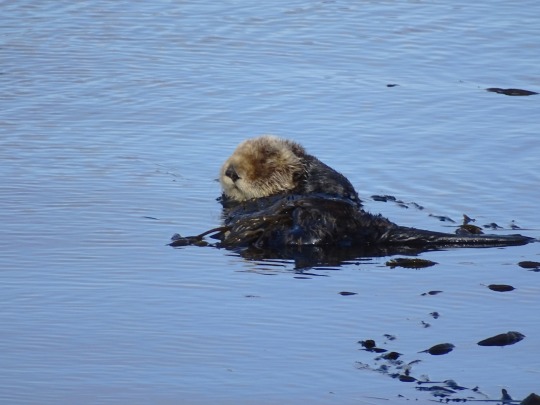
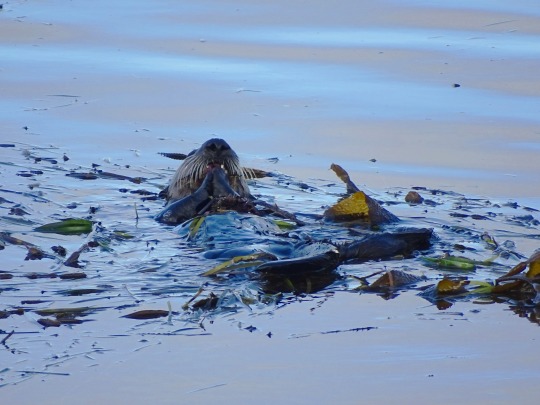
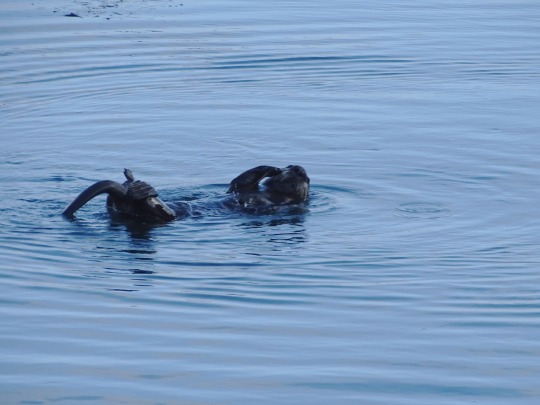
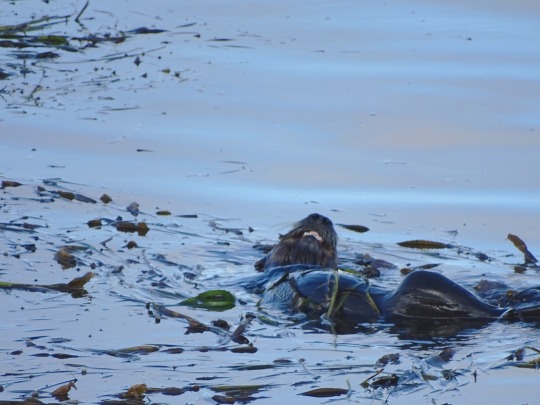
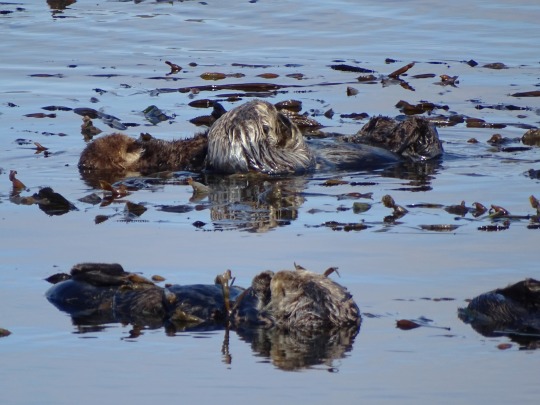
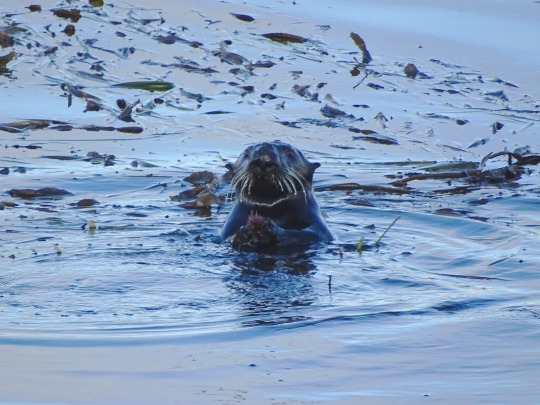
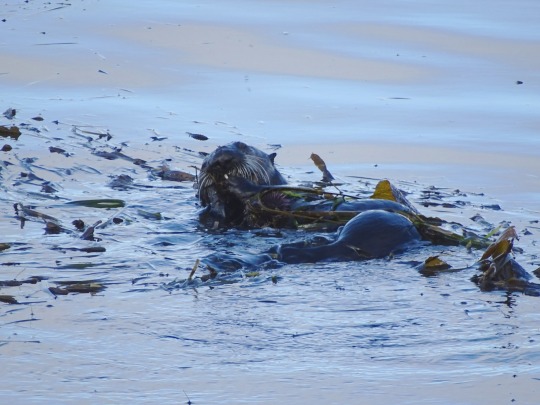
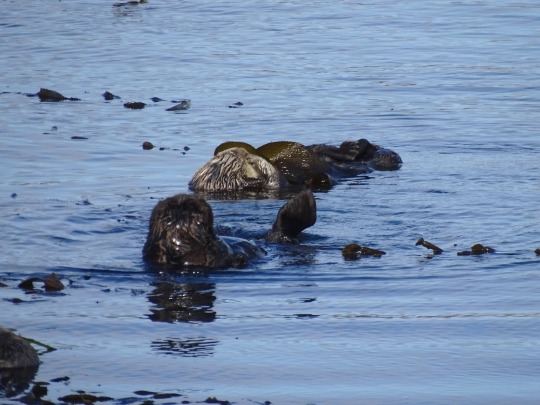
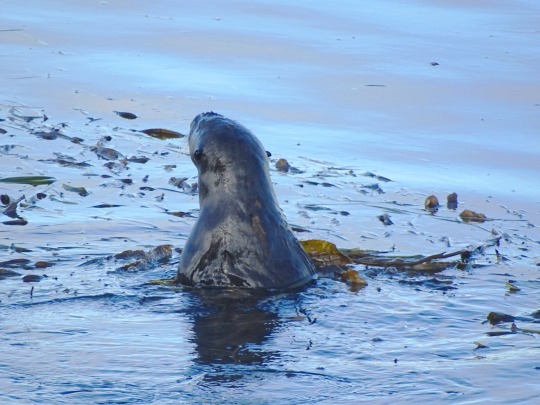
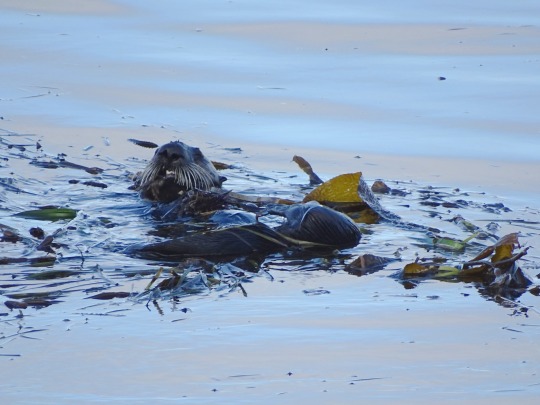
Sea Otter Heaven, Morro Bay (No. 6)
Although the southern sea otter's range has continuously expanded from the remnant population of about 50 individuals in Big Sur since protection in 1911, from 2007 to 2010, the otter population and its range contracted and since 2010 has made little progress. As of spring 2010, the northern boundary had moved from about Tunitas Creek to a point 2 kilometres (1.2 mi) southeast of Pigeon Point, and the southern boundary has moved along the Gaviota Coast from approximately Coal Oil Point to Gaviota State Park. A toxin called microcystin, produced by a type of cyanobacteria (Microcystis), seems to be concentrated in the shellfish the otters eat, poisoning them. Cyanobacteria are found in stagnant water enriched with nitrogen and phosphorus from septic tank and agricultural fertilizer runoff, and may be flushed into the ocean when streamflows are high in the rainy season. A record number of sea otter carcasses were found on California's coastline in 2010, with increased shark attacks an increasing component of the mortality. Great white sharks do not consume relatively fat-poor sea otters but shark-bitten carcasses have increased from 8% in the 1980s to 15% in the 1990s and to 30% in 2010 and 2011.
Source: Wikipedia
#Sea Otter Heaven#California sea otter#Enhydra lutris#Morro Bay#hotel#travel#original photography#vacation#tourist attraction#USA#summer 2022#Califorina#West Coast#San Luis Obispo County#wildlife#animal#seaweed#Morro Rock Ecological Preserve#Pacific Ocean#beach#cityscape#landscape#seascape#kelp#fauna#landmark#marine mammal
10 notes
·
View notes
Text
Despite It All...
Despite the seemingly snowy winter in the west Washington state remains in a drought according to the Natural Resources Conservation Service. This organization monitors and publishes reports on, among other things, the water supply for Washington. According to the NRCS's latest report published May 1, statewide snowpack was 71% of normal. Furthermore, most areas in the state are in snow drought except for the area near Mount Saint Helens.
In the North Cascades the snow appears to be melting slowly. The report indicates this could could help keep streamflows higher in the spring and summer. Nevertheless the runoff will likely still be lower than normal. The state declared a statewide drought on April 16.
What does this mean for hikers in the Cascades? There is no clear answer except to be prepared. Carrying a little more water may be a prudent strategy as some streams and creeklets may be drier than normal. The greater risk is fire. We know a very early fire season started over a month ago in northern Alberta and British Columbia. It would not be welcome nor would it be surprising to experience an early fire season in the Cascades. Being prepared for such events includes making sure friends and family know where you are going and when you plan to return. Signing in and out at trailheads and/or ranger stations help keep hikers safe and lessens the risk for first responders in the event hikers are caught in or near a fire.
The past few years have seen PCT hikers get so close but yet so far from the northern terminus due to fires in the North Cascades that ultimately closed the trail in September and October. Some potential exists as the region transitions from an El Niño climate pattern to La Niña, which typically means wetter weather in the Northwest from mid-June to early-July. That could provide some buffer for the dry summer, however no one can be sure.
So, despite what seemed like, felt like, looked like a wet winter in Washington maybe wasn't all it was cracked up to be. Our fingers are crossed for a summer that is not remembered for fire and smoke but more for making great memories in the outdoors.

5 notes
·
View notes
Text
Two PNW tribal nations sue oil companies over costs of climate change
https://www.seattletimes.com/seattle-news/environment/two-pnw-tribal-nations-sue-oil-companies-over-costs-of-climate-change/
Major oil companies for decades deliberately sought to downplay and discredit scientific warnings about the central role of fossil fuels in causing climate change, alleges two lawsuits filed this week by the Makah and Shoalwater Bay tribes.
The lawsuits filed in King County Superior Court name ExxonMobil, BP, Shell, Chevron, ConocoPhillips and Phillips 66 as defendants, and seek compensation for the millions of dollars already spent, and likely to be spent in the future, for the tribes to respond to climate-induced disasters such as extreme heat, drought, wildfire, shoreline erosion, sea level rise and flooding.
The lawsuits allege the companies have known fossil fuels would cause catastrophic climate change since at least 1959, but continued marketing massive quantities of oil and gas. They allege the oil companies tried to mislead the public by funding op-eds and advertisements in Seattle and national newspapers that claimed the science of climate change was uncertain or lacking evidence.
The complaints outline the companies’ research and misleading marketing around their products’ role in causing climate change and the sea level rise, extreme weather, public health harms and other climate effects on the tribes and their lands.
With both the Makah and Shoalwater Bay reservations on the Pacific Ocean, they are particularly vulnerable to sea level rise, the lawsuits state. Both tribes have already incurred the costs of moving their citizens to higher ground, and ocean acidification “at an alarming rate” from burning fossil fuels has endangered the tribes’ coastal ecosystems and economy, according to the lawsuits.
“We are seeing the effects of the climate crisis on our people, our land, and our resources. The costs and consequences to us are overwhelming,” said Makah Tribal Council Chair Timothy J. Greene, Sr. in a statement. “We intend to hold these companies accountable for hiding the truth about climate change and the effects of burning fossil fuels. And we aim to force them to help pay for the high costs of surviving the catastrophe caused by the climate crisis.”
The lawsuits also cite a report by the Climate Impacts Group at the University of Washington that suggests with global warming of at least 1.5 degrees Celsius by 2050, Washington is projected to experience a 67% increase in the number of days per year above 90 degrees, relative to 1976-2005, leading to an increased risk of heat-related illness and death, warmer streams and more frequent algal blooms.
The report also found warming would fuel a decrease of 38% in snowpack, relative to 1970-99, leading to reduced water storage, irrigation shortages, and winter and summer recreation losses, as well as increases in winter streamflow, decreases in summer streamflow, leading to reduced summer hydropower, conflicts over water resources and negative effects on salmon.
“These oil companies knew their products were dangerous, yet they did nothing to mitigate those dangers or warn any of us about them, for decades,” said Shoalwater Bay Chair Charlene Nelson in a written statement. “Now we are facing hundreds of millions of dollars in costs to relocate our community to higher ground and protect our people, our property, and our heritage. These companies need to be held accountable for that.”
The tribes bring their claims under Washington’s Products Liability Act for failure to warn, misrepresentation and intentional concealment. The complaints request jury trials, and ask the court to order the companies to create a fund to be managed by the tribes to remediate and adapt reservation lands, natural resources and infrastructure to climate change.
#Washington state#makah#shoalwater bay tribe#climate change#fossil fuels#environment#indigenous activism
12 notes
·
View notes
Photo

When do streamflow droughts occur?
by u/houndrunner
7 notes
·
View notes
Text
How AI can help protect California streams and fish
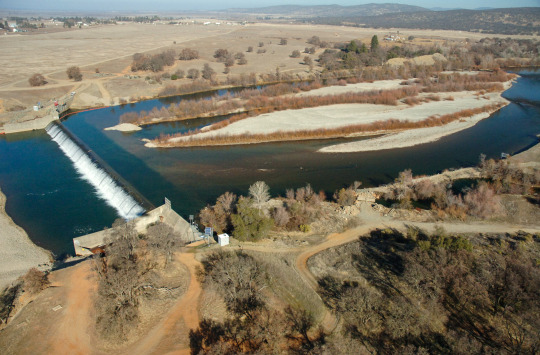
A new AI model that tracks peak streamflows could help keep CA water diversions from threatening salmon and other at-risk species. “There’s a lot of interest in diverting all the peak flows in wet years―but this will harm ecosystems.”
Maven's Notebook 2024
2 notes
·
View notes
Text
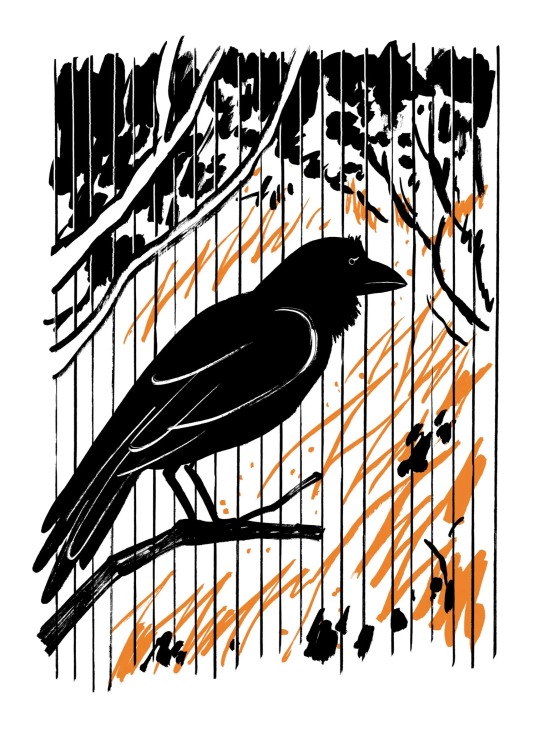
Illustration by João Fazenda
The Burning of Maui
The governor called the fires Hawaii’s “largest natural disaster” ever. They would more accurately be labelled an “unnatural disaster.”
— By Elizabeth Kolbert | August 20, 2023
The ‘alalā, or Hawaiian crow, is a remarkably clever bird. ‘Alalā fashion tools out of sticks, which they use, a bit like skewers, to get at hard-to-reach food. The birds were once abundant, but by the late nineteen-nineties their population had dropped so low that they were facing extinction. Since 2003, all the world’s remaining ‘alalā have been confined to aviaries. In a last-ditch effort to preserve the species, the San Diego Zoo Wildlife Alliance has been breeding the crows in captivity. The alliance keeps about a third of the birds—some forty ‘alalā—at a facility outside the town of Volcano, on the Big Island, and the rest outside the town of Makawao, on Maui. Earlier this month, the Maui population was very nearly wiped out. On the morning of August 8th, flames came within a few hundred feet of the birds’ home and would probably have engulfed it were it not for an enterprising alliance employee, one of her neighbors, and a garden hose.
According to the U.S. Fish and Wildlife Service, “many factors” contributed to the ‘alalā’s decline, including habitat destruction, invasive species, and the effects of agriculture on the landscape. Owing to these developments, Hawaii’s native fauna in general is in crisis; the state has earned an unfortunate title as “the extinction capital of the world.” Of the nearly hundred and fifty bird species that used to be found in Hawaii and nowhere else, two-thirds are gone. Among the islands’ distinctive native snails, the losses have been even more catastrophic.
Last week, as the death toll from the fires in West Maui continued to mount—late on Friday, the number stood at a hundred and eleven—it became clear that the same “factors” that have decimated Hawaii’s wildlife also contributed to the deadliness of the blazes. Roughly a thousand people have been reported as still missing, and some two thousand homes have been destroyed or damaged. The worst-hit locality, the town of Lahaina, which lies in ruins, was built on what was once a wetland. Starting in the mid-nineteenth century, much of the vegetation surrounding the town was cleared to make way for sugar plantations. Then, when these went out of business, in the late twentieth century, the formerly cultivated acres were taken over by introduced grasses. In contrast to Hawaii’s native plants, the imported grasses have evolved to reseed after fires and, in dry times, they become highly flammable.
“The lands around Lahaina were all sugarcane from the eighteen-sixties to the late nineteen-nineties,” Clay Trauernicht, a specialist in fire ecology at the University of Hawaii at Mānoa, told the Guardian. “Nothing’s been done since then—hence the problem with invasive grasses and fire risk.”
Also contributing to the devastation was climate change. Since the nineteen-fifties, average temperatures in Hawaii have risen by about two degrees, and there has been a sharp uptick in warming in just the past decade. This has made the state more fire-prone and, at the same time, it has fostered the spread of the sorts of plants that provide wildfires with fuel. Hotter summers help invasive shrubs and grasses “outgrow our native tree species,” the state’s official Climate Change Portal notes.
As Hawaii has warmed, it has also dried out. According, again, to the Climate Change Portal, “rainfall and streamflow have declined significantly over the past 30 years.” In the weeks leading up to the fires in West Maui, parts of the region were classified as suffering from “severe drought.” Meanwhile, climate change is shifting storm tracks in the Pacific farther north. Hurricane Dora, which made history as the longest-lasting Category 4 hurricane on record in the Pacific, passed to the south of Maui and helped produce the gusts that spread the Lahaina fire at a speed that’s been estimated to be a mile per minute.
After visiting the wreckage of Lahaina, Hawaii’s governor, Josh Green, called the Maui fires the “largest natural disaster Hawaii has ever experienced.” In fact, the fires would more accurately be labelled an “unnatural disaster.” As David Beilman, a professor of geography and environment at the University of Hawaii at Manoa, recently pointed out, for most of Hawaii’s history fire simply wasn’t part of the islands’ ecology. “This Maui situation is an Anthropocene phenomenon,” he told USA Today.
A great many more unnatural disasters lie ahead. Last month was, by a large margin, the hottest July on record, and 2023 seems likely to become the warmest year on record. Two days after Lahaina burst into flames, the National Oceanic and Atmospheric Administration issued a revised forecast for the current Atlantic hurricane season, which runs through the end of November. The agency had been predicting a “near-normal” season, with between five and nine hurricanes. But, because of record sea-surface temperatures this summer—last month a buoy in Manatee Bay, south of Miami, registered 101.1 degrees, a reading that, as the Washington Post put it, is “more typical of a hot tub than ocean water”—noaa is now projecting that the season will be “above normal,” with up to eleven hurricanes. Rising sea levels and the loss of coastal wetlands mean that any hurricanes that make landfall will be that much more destructive.
A few days after noaa revised its forecast, officials ordered the evacuation of Yellowknife, the capital of Canada’s Northwest Territories. A wildfire burning about ten miles away would, they feared, grow to consume the city. The Canadian Broadcasting Corporation called the evacuation order “extraordinary.” This summer has been Canada’s worst wildfire season on record, and, at times, the smoke has spread all the way to Europe. There are currently something like a thousand active fires in the country.
Two days after the Yellowknife evacuation was ordered, another Pacific hurricane—Hilary—intensified into a Category 4 storm. Hilary was being drawn north by a “heat dome” of high pressure over the central Plains, which was expected to bring record temperatures to parts of the Midwest. The storm’s unusual track put some twenty-six million people in four states—California, Utah, Nevada, and Arizona—under flash-flood watches.
How well humanity will fare on the new planet it is busy creating is an open question. Homo sapiens is a remarkably clever species. So, too, was the ‘alalā. ♦
— Published in the Print Edition of the August 28, 2023, New Yorker Issue, with the Headline “Fire Alarm.”
#Maui#Natural Disaster | Un-natural Disaster#Elizabeth Kolbert#The New Yorker#Alalā | Hawaiian Crow#San Diego Zoo Wildlife Alliance#U.S. Fish and Wildlife Service#Lahaina#Clay Trauernicht | University of Hawaii at Mānoa#Climate Change Portal#Hawaii’s Governor | Josh Green#David Beilman | University of Hawaii at Manoa#Anthropocene Phenomenon#National Oceanic and Atmospheric Administration#Atlantic Hurricane 🌀#Manatee Bay | South of Miami#Yellowknife | Canada’s 🇨🇦 Northwest Territories#Europe#Pacific Hurricane 🌀#Mid-West | California | Utah | Nevada | Arizona#Fire 🔥 Alarm 🚨
3 notes
·
View notes
Text









#nature#water#stream#naturephotography#outdoors#river#scenery#flowingwater#waterflow#waterphotography#runningwater#creek#streamflow#rushingwater#watercurrent#peacefulstream
4 notes
·
View notes
Text
Ways to Recharge Groundwater
Water is one of our most precious resources, and groundwater plays a vital role in sustaining life on Earth. Groundwater serves as a primary source of drinking water for millions of people and supports ecosystems by maintaining streamflow and wetlands. However, increasing demand and over-extraction of groundwater have led to declining water tables in many regions.
#Ways to Recharge Groundwater#rainwater harvesting system#rainwater harvesting#rainwater harvesting Solution#rain water harvesting company in gurgaon
2 notes
·
View notes
Text
Streamflow Turns Protocol Revenue Into Staking Rewards
Streamflow, a leading token distribution platform on Solana, is transforming staking with the launch of Active Staking Rewards, a revolutionary system that offers non-inflationary rewards to STREAM holders. This new model links staking rewards directly to protocol usage, creating a sustainable and transparent incentive mechanism for the Streamflow community. Unlike traditional staking
Read More: You won't believe what happens next... Click here!
0 notes
Text
Hour 31 of Weather and Climate Livestream!!
Current talk: Seasonal forecasts of Climate and Streamflow in Snow-fed Rivers
0 notes
Text
Groundwater overuse puts Brazil’s river flow at risk, study finds

A recent study reveals the potential risk of river water flowing underground in Brazil due to high groundwater extraction, which could lead to losses in streamflow.
Researchers found a correlation between groundwater use and river flow reductions, particularly in dryland areas.
Overexploitation of groundwater could severely affect Brazil’s agriculture, energy production, and ecosystems, with illegal and unregistered wells likely contributing to the problem.
Experts stress the importance of improving water resource management, with calls for better hydrogeological monitoring and more localized studies to better understand the potential harms facing Brazil’s water sources.
Continue reading.
2 notes
·
View notes